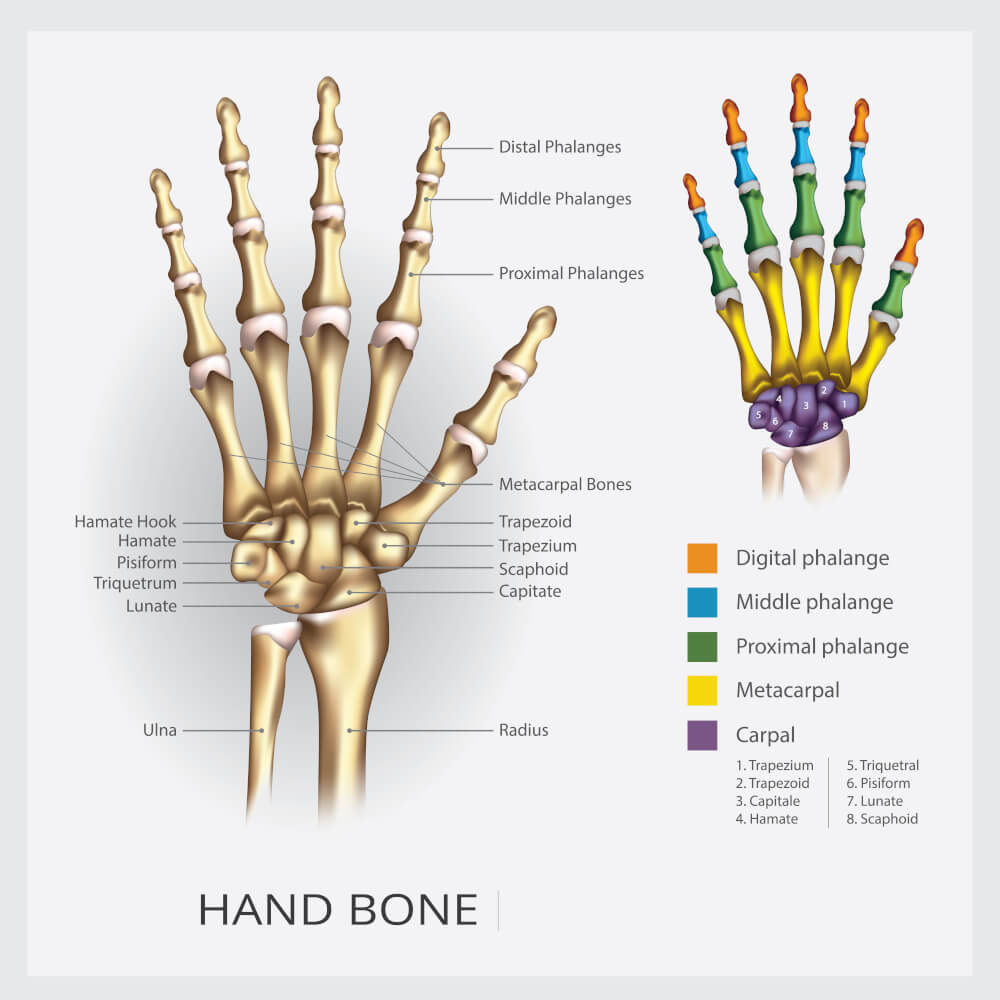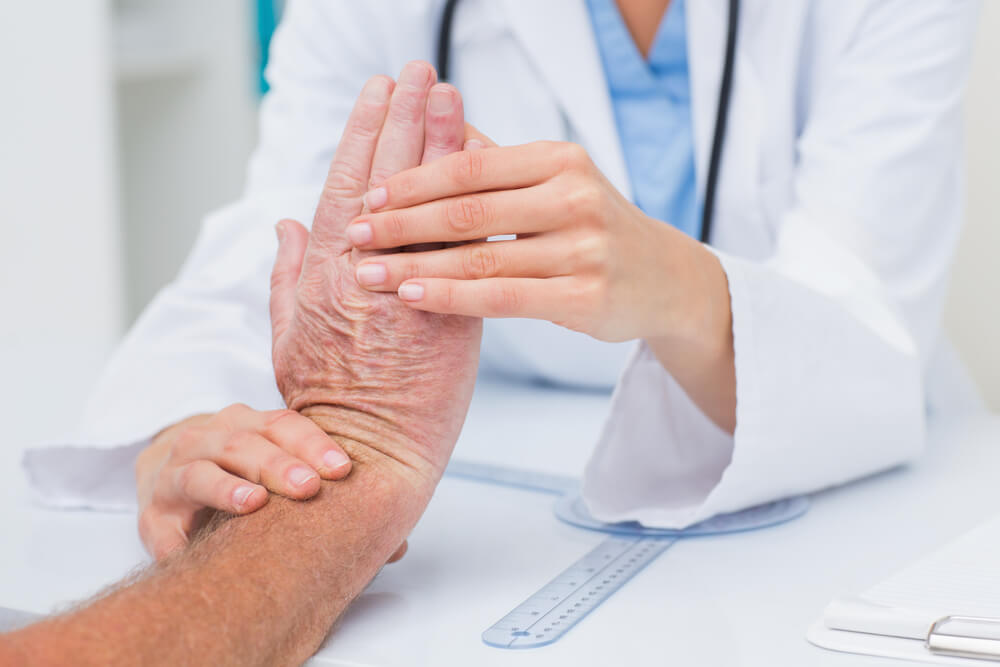Fractures
Home » Treatment » Hand & Wrist » Fractures
Understanding Hand & Wrist Fractures
A fracture of the hand or wrist, a common injury resulting from trauma or impact, can significantly impair an individual’s ability to perform everyday tasks. The intricate structure of the hand and wrist, comprising bones, joints, ligaments, and tendons, makes them vulnerable to fractures. The severity of a fracture ranges from minor cracks to complete breaks, necessitating prompt and appropriate treatment. As hand therapists, we play a crucial role in the rehabilitation process, employing a variety of techniques to restore function and reduce pain.
If you have a question about whether your condition should be treated by one of our hand therapists, call Restored Hope Hand Therapy at (928) 275-2201.
Anatomy of the Hand
A hand fracture, a common injury resulting from trauma or impact, can significantly impair an individual’s ability to perform everyday tasks. The intricate structure of the hand and wrist, comprising bones, joints, ligaments, and tendons, makes them vulnerable to fractures. The severity of a fracture ranges from minor cracks to complete breaks, necessitating prompt and appropriate treatment. As hand therapists, we play a crucial role in the rehabilitation process, employing a variety of techniques to restore function and reduce pain.

Anatomy of the Wrist
When Fractures Occur
When a force exceeds the bone’s ability to absorb it, fractures may occur. The severity of a hand fracture can vary, categorized as:
- Non-displaced Fracture: Where the bone is cracked but stays in place, or
- Displaced Fracture: Where the bone is broken and moves out of alignment.
Common symptoms include pain, bruising and swelling, deformity, numbness or tingling, and difficulty moving the affected hand or fingers.
Wrist fractures can manifest in various types, each dependent on the specific bones and patterns of injury. Diagnostic procedures, such as X-rays and sometimes CT scans, help determine the location and extent of the fracture, guiding the treatment plan.
- Distal Radius Fracture: A distal radius is the most common type of wrist fracture and often results from a fall on an outstretched arm. There are different ways the distal radius can break, and it is important to classify the type of fracture in order to treat it effectively.
- Scaphoid Fracture: Scaphoid fractures are the second-most common type of wrist fracture, but they can be difficult to identify and treat. They often occur due to trauma, such as when a person uses an outstretched hand in an attempt to break a fall but can also result from injuries during sports and auto accidents.
- Barton’s Fracture: A distal radius fracture with the addition of a dislocation in the radiocarpal (wrist) joint. A Barton’s fracture often requires surgery to fix.
- Chauffer’s (Radial Styloid) Fracture: Occurs when the radial styloid (the bulge at the end of the radius bone near the base of the thumb) gets fractured. It is usually caused by a direct blow to the radius and often requires surgery.
- Ulnar Styloid Fracture: Occurs when the bulge at the end of the ulna bone, known as the styloid, gets fractured. The ulnar styloid is the visible bulge on the outside of the wrist. This fracture often occurs in conjunction with a distal radius fracture as the result of a fall and may require surgery.

Treatment of Hand & Wrist Fractures
The approach to treating a fractures depends on various factors, including the type and location of the fracture, as well as the patient’s overall health. In less severe cases, splinting or casting may be sufficient to immobilize the hand, allowing the bones to heal naturally. For more complex fractures, surgical intervention may be required to realign and stabilize the bones using pins, plates, or screws.
Regardless of the chosen treatment, rehabilitation is a crucial component of the recovery process. This is where Restored Hope Hand Therapy, skilled in the intricacies of hand anatomy and function, comes into play.
Role of Hand Therapists
Hand therapists at Restored Hope are occupational therapists with specialized training in the rehabilitation of upper extremity conditions, including hand and wrist fractures. Our goal is to optimize the patient’s hand function, reduce pain, and enhance overall quality of life. The treatment plan is tailored to each individual, considering factors such as the type of fracture, surgical interventions, and the patient’s specific needs.
- Immobilization and Edema Control: We may initially focus on controlling swelling and promoting healing by designing custom splints or braces. These devices provide support and immobilization, preventing further damage while reducing pain and swelling.
- Pain Management: Implementing strategies to manage pain and swelling.
- Range of Motion Exercises: Once the initial healing phase is complete, we’ll introduce controlled range of motion exercises. These exercises are designed to prevent stiffness and promote flexibility in the affected joints, gradually restoring the hand’s normal function.
- Strength Training: Strengthening exercises play a crucial role in rebuilding muscle strength and endurance. We may employ various techniques, such as resistance training and isometric exercises, to gradually enhance the hand’s ability to perform everyday activities.
- Scar Management: Surgical interventions often leave scars, and we can assist in managing and minimizing scar tissue. Massage, stretching, and other techniques can improve the appearance and functionality of scars, preventing them from restricting movement.
- Education and Functional Activities: The ultimate goal of hand therapy is to reintegrate the patient into their daily activities. We’ll educate on how to prevent future injuries and maintain hand health. We’ll design rehabilitation programs that simulate real-life tasks, ensuring the hand can perform essential functions, from grasping objects to intricate hand movements.
Hand and wrist fractures can significantly alter the pace and ease of daily life. However, with the right medical and therapeutic assistance, recovery and return to normalcy are within reach. If you are facing the challenge of a hand or wrist fracture, do not hesitate to reach out for professional help. Call us today and take the first step towards expert care, personalized treatment, and a seamless journey to recovery.
Hand & Wrist Therapy Options
individualized-specific therapy programs to offer you the best possible results.
Hand & Wrist
- Arthritis
- Carpal & Cubital Tunnel Syndromes
- De Quervain's Tenosynovitis
- Dislocations
- Dupuytren's Contracture
- Flexor Tendon Injuries
- Fractures
- Ganglion Cyst
- Ligament Tears
- Mallet Finger
- Sprains & Strains
- Tendon Transfer Neuro Re-education
- Trigger Finger
- Wrist Sprain

